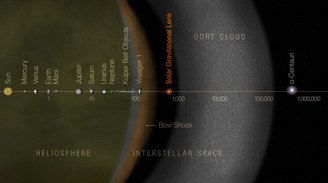The idea seems to be taken from a science fiction story, But not only is it doable, it was designed by Albert Einstein himself.: If we can take the space telescope to a region in our Solar System where the light coming from behind the Sun is focused, without being bent by the gravity of our star, we can build a super telescope.
According to calculations of the father of modern physics, this location, approximately 550 Astronomical Units (AU) from the Sun, could host an optical instrument capable of observing the surfaces of exoplanets, eliminating the need for large space telescopes. At the time, Einstein shelved the project, admitting that “it is unlikely that we will ever get close enough to this center line.”
But almost a hundred years later, The idea of using the Sun as a telescope received approval in the NIAC program (NASA Advanced Innovative Concepts); A study on how this project can be implemented is currently in Phase III. In phase..
Using the Sun’s gravitational lens to observe exoplanets
The first person to propose a space mission to build Einstein’s hypothetical telescope was Stanford University electrical engineer Von R. Eshleman, who died in 2017. In an article published in Science magazine in September 1979, This pioneer in planetary science and radio explained how the device might work.
“The Sun’s gravitational field acts as a spherical lens to magnify the intensity of radiation from a distant source along a semi-infinite focal line,” the study says. This means that a space telescope installed anywhere along this line could theoretically “observe, listen, and communicate across interstellar distances.”
Von R. Eshleman and his team noted that equipment to perform such observations was already available at the time the study was conducted. The question was (and still is) how to get there. Placing an observatory “behind” the Sun according to the perspective of the object we want to observe, It will allow us to use the magnifying power of the Sun’s gravity (100 million times that of a 1-millimeter radio wave) to obtain much more detailed images..
When will we observe exoplanets with a telescope behind the Sun?

Although we already have the technology to use gravitational lenses and see incredibly distant objects, we are somewhat dependent on the “luck” of a large object being in the right position when we make an observation. But placing a telescope on the opposite side of the Sun would give us a kind of giant “personalized” lens that would allow us to observe distant exoplanets in great detail.
Considering that the Voyager I probe has traveled more than 160 AU of interstellar space since its launch in 1977, Einstein’s distance seems more achievable today. In this sense, the NASA project proposes a “swarm architecture” in which small satellites with solar sails could reach the position designed by the physicist in less than 25 years.
Follow the latest developments in technology and science at TecMundo. If you wish, take the opportunity to learn the story of the Sun’s possible twin brother.
Source: Tec Mundo
I’m Blaine Morgan, an experienced journalist and writer with over 8 years of experience in the tech industry. My expertise lies in writing about technology news and trends, covering everything from cutting-edge gadgets to emerging software developments. I’ve written for several leading publications including Gadget Onus where I am an author.












